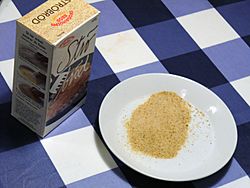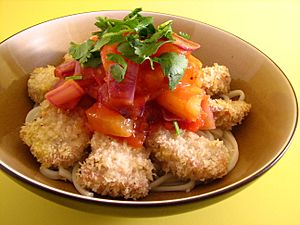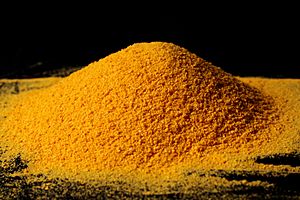Bread crumbs facts for kids

Commercially produced breadcrumbs
|
|
| Alternative names | Breading, crispies |
|---|---|
| Main ingredients | Dried bread |
| Variations | Panko |
Bread crumbs are small pieces of dried bread. People use them in cooking for many reasons. They can make a crispy coating for fried foods, like chicken or fish. You can also use them to top casseroles, stuff poultry, or thicken stews. Sometimes, people add seasonings to bread crumbs for extra flavor. A special Japanese type of bread crumb is called panko.
Contents
Discover Different Types of Bread Crumbs
There are a few main kinds of bread crumbs, each used for different cooking styles.
Dry Bread Crumbs: Sandy or Powdery
Dry bread crumbs are made from very dry bread. This bread is often baked or toasted to remove almost all the water. These crumbs can feel sandy or even like powder. It's easy to make them at home using a food processor or a grater. You can make them coarse (larger pieces) or fine (smaller pieces).
Fresh Bread Crumbs: Softer and Bigger
Fresh bread crumbs are made from bread that isn't quite as dry. This means the crumbs are usually larger and softer. They are great for making a softer coating, crust, or stuffing for food. The word "crumb" also describes the soft, inner part of a loaf of bread, different from the hard crust.
Panko: The Crispy Japanese Crumb
Panko (pronounced PAN-koh) is a special kind of flaky bread crumb. It comes from Japanese cuisine and is famous for making fried foods extra crunchy. Think of dishes like tonkatsu, which is a breaded pork cutlet.
Panko is made from bread baked using electricity, which creates a loaf without a crust. This bread is then ground into fine slivers. Panko has a lighter, airier texture than most Western breadings. It stays crispy whether you bake it or deep-fry it. This makes your food feel lighter and less greasy.
You can find panko in many Asian markets and large supermarkets today. It's used in many dishes, not just Asian ones, especially with seafood. Panko is made all over the world, including in Japan, Korea, and other Asian countries.
Where Did the Word "Panko" Come From?
The Japanese learned how to make bread from Europeans a long time ago. The word パン粉 (panko) combines two parts. "Pan" comes from the Portuguese word "pão," which means bread. The second part, "-粉 (-ko)," is a Japanese Kanji character. It means "flour," "coating," "crumb," or "powder." You might see "-ko" in other Japanese words like komeko (rice powder) or komugiko (wheat flour).
Breading: Giving Food a Crispy Coat
Breading is also called crumbing. It's a dry coating made from bread crumbs or a mix of ingredients. People use it to cover food before cooking, especially for frying. Breading helps create a super crispy layer around the food.
A breading mix can include bread crumbs, flour, cornmeal, and seasonings. You dip the food into this mix. If the food is too dry for the coating to stick, you might first dip it in a liquid. This could be buttermilk, raw egg, or an egg wash.
Breading is different from batter. Batter is a liquid coating, usually made with flour and water or milk. Batter makes a smoother texture, while breading gives a crunchy, crispier feel.
Bread crumbs are famous from the fairy tale "Hansel and Gretel". In the story, Hansel and Gretel use bread crumbs to mark their path in the woods. But birds eat the crumbs, and the children get lost.
This fairy tale made the word "breadcrumb" popular in a new way. Now, "breadcrumbs" are a common feature on websites and in computer programs. They show you where you are in a website or document. It's like a trail that helps you find your way back to where you started.
Images for kids
-
Panko on Tonkatsu
See also
 In Spanish: Pan rallado para niños
In Spanish: Pan rallado para niños










